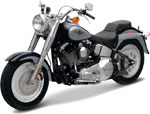Dear Umbra,
I recently read a claim that “motorcycles produce far more pollution per mile than your typical car, truck, or SUV.” Is that true? I’ve got a friend who’s currently making her (bad-ass) way across country on a Harley — 60 mpg, baby — and we are both curious about the environmental impacts compared with a car.
Billy
Brooklyn, N.Y.
Dearest Billy,
Bad news for your friend and her bad behind. If she’s getting 60 miles per gallon, that’s about three times better than the average car these days, and certainly far better than the 1984 Nissan Rustbucket that I drove across country when I made my pilgrimage to Gristonia years ago. (Appalling, I know, but I was young, and the car was free.)

Emissions hog.
However, and this is the word from California — where they actually care about car exhaust, post signs in garages warning that carcinogens are present, and have an entire government department devoted to breathing — anyway, the word from California is that the cleanest 2004 motorcycle is eight to nine times dirtier than the dirtiest 2004 car. Put differently, the best allowable California motorcycle is many times worse than the worst allowable California car. This “worst” is in terms of pollutants, not greenhouse gases. The U.S. EPA says the motorcycle hydrocarbon burden is 90 times higher than that of the typical passenger car, and a motorcycle releases 20 times more total pollution per mile than a new car.
Why is such a high-mileage engine so dirty? Well, I’m glad you asked, because it means: Time to talk about the internal combustion engine! Our car engines are powered by endlessly repeating small explosions. Gas is forced into a small space and then ignited, resulting in a powerful explosion: Think aerosol cans in a campfire. The energy from the explosion is used to move other parts of the engine, such as pistons, cranks, rods, reels, hooks, etc. Excitingly comprehensible diagrams of this process can be found at HowStuffWorks.com. If an engine were perfectly efficient, the only combustion byproducts would be carbon dioxide and water. Instead, we get other byproducts, such as carbon monoxide, hydrocarbons, particulate matter, and nitrous oxides, which are poisonous/smog-forming/depressing. That’s what’s following after your pal’s bad behind.
Car engines have become cleaner over time through innovations (such as fuel injection) that allow fuel to burn more efficiently. Catalytic converters also clean up car exhaust by converting harmful compounds as they pass through a catalyst. (Go figure.) Motorcycle manufacturers have been slow to add efficiency and catalytic converters to their engines but are working with regulators to clean up their acts. Trouble is, anything that adds weight to the engine can impede its bad-ass performance. Motorcycle regulations are steadily improving, and the feds are following California’s guidelines. Still, to date, motorcycles are bad, bad, bad.
On our other theme, motorcycles are not safe. Here’s my horror story: A friend, who thinks she’s driving her motorcycle defensively, being careful, etc., is on the interstate when the car in front of her brakes suddenly. She rear-ends the car, is thrown off her bike, flies over the car she hit, and then is run over by the car she hit and the car that used to be behind her. Amazingly enough, she is alive and well and living in New York. You would recognize her by a strangely protuberant collarbone. Consider yourself warned and your friend insane.
Cautiously,
Umbra
